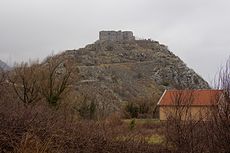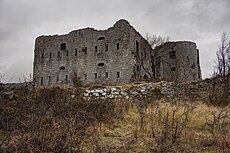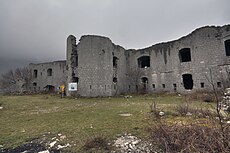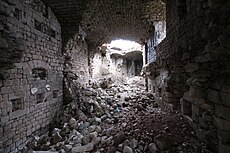Fort Kosmač
| Fort Kosmač | |
|---|---|
Tvrđava Kosmač | |
| Brajići, near Austro-Hungarian Empire | |
| In use | 1840s–1918 (Austro-Hungarian Empire) 1941–43 (Italy) |
| Materials | Concrete, limestone |
| Battles/wars | Krivošije rebellion (1869), First World War, Second World War |
Fort Kosmač (
Background
Until 1918, the Austro-Hungarian Empire controlled a narrow coastal strip from Kotor (known then as Cattaro) to just south of Petrovac, previously known as the Venetian Albania. At Budva, about half-way along this strip, a road leads through the mountains above the town to Cetinje, the old Montenegrin capital. The area was of great strategic significance as it was the point at which the Austro-Hungarian, Montenegrin and (until 1878) Ottoman borders met.[1]
In 1841 Prince Petar II Petrović-Njegoš of Montenegro reached an agreement with Austria under which the border between Montenegro and the empire was demarcated, and the Austrians recognised Montenegro's independence.[2] Fort Kosmač was built as the southernmost part of a network of fortifications constructed by the Austrians around the Bay of Kotor and along the coastal strip. However, Austrian control of the area was not secure. Two serious rebellions were mounted by the powerful Krivošije clan who lived on the eastern flanks of Mount Orjen above Risan. In 1869 the clan defeated an Austro-Hungarian force sent to quell their rebellion, while their local allies attacked Fort Kosmač. A second rebellion in 1882 was eventually put down by the Austrians.[1]
Description
The fort is located on the hill of Kosmač, close to the village of Brajići on the Budva-Cetinje road, at an altitude of about 800 metres (2,600 ft) above sea level. It was constructed using finely-dressed limestone obtained from local quarries. The fort was built on a roughly north–south alignment and consists of a symmetrical building with two wings meeting a central semi-circular section at an angle of about 20 degrees. The end of each wing has a semi-circular extension that faces east at a right angle to the main line of the wing. This design gave the fort's defenders views in eight directions, with rectangular windows and large arched gun ports facing out over the hinterland. The central semicircular tower faces west and seaward.[3]
The fort is now in a ruinous condition; it once had three storeys, but the topmost storey has collapsed entirely, leaving it roofless. The interior walls, floors and central staircase have also collapsed.[4] Although the remains of the main staircase are still visible, the steps have disappeared entirely and the upper level cannot be reached, though there is nothing left of the upper floor to stand on in any case.[3]
The interior of the fort is strewn with large quantities of fallen masonry, completely obscuring the original floor level. The extent of the collapse is so complete that it is no longer known how the interior was originally laid out. There are substantial holes in the interior's vaulted ceiling. The exterior has been subjected to some stone-robbing in pursuit of the finely-worked square blocks of grey limestone that were used to line the fort's outer walls.[3]
A spacious courtyard is situated outside the fort and was once flanked by a garrison building, of which only fragments now remain. A cistern that provided the garrison's water supply is also located in this area.[5]
The fort is readily accessible and is the site of a waypoint along the long-distance footpath, the Primorska planinarska transverzala, that leads along the Montenegrin coast. However, its ruined state means that there is a significant risk of falling masonry and visitors are advised to be extremely cautious in entering the building.[6]
History
The construction of Fort Kosmač probably began shortly after the border was demarcated in 1841; it was completed around 1850.
The current design of Fort Kosmač dates from 1909, when it was armed with 8 mm machine guns, 90 mm KM-04 artillery guns and 150 mm cannons. It continued to be occupied by the Austro-Hungarians until the end of the
The Ministry of Culture of Montenegro describes Fort Kosmač as being "of outstanding national importance."[5] Although the fort is now in an advanced state of ruination, proposals have been advanced to save it. This could be done either by shoring it up and arresting the progressive collapse of the building, preserving it as a ruin and a site of memory, or by restoring it and using it as accommodation (such as a youth hostel or holiday apartments) or as a cultural complex. The cost of preserving and restoring the fort was estimated in 2005 to be up to around €1.7 million.[5] However, as of 2017, the fort continues to be neglected and its disintegration is still ongoing.
References
- ^ ISBN 978-1491273272.
- ISBN 978-1-57607-294-3.
- ^ ISBN 978-92-871-5825-3.
- ^ See this photograph for the fort's appearance prior to its abandonment.
- ^ a b c "Fortress Kosmac". Regional Cooperation Council, Secretariat of the Task Force on Culture and Society, Ministry of Culture of Montenegro. Retrieved 29 April 2015.
- ^ Sullivan, pp. 86, 88
- ^ a b c Sullivan, p. 84
- ^ "Austrougarske tvrđave u Budvi". Primorske novine. 20 November 2013. Retrieved 29 April 2015.
- ^ "The Insurrection in Dalmatia". The Morning Post. London. 13 November 1869. p. 5.






